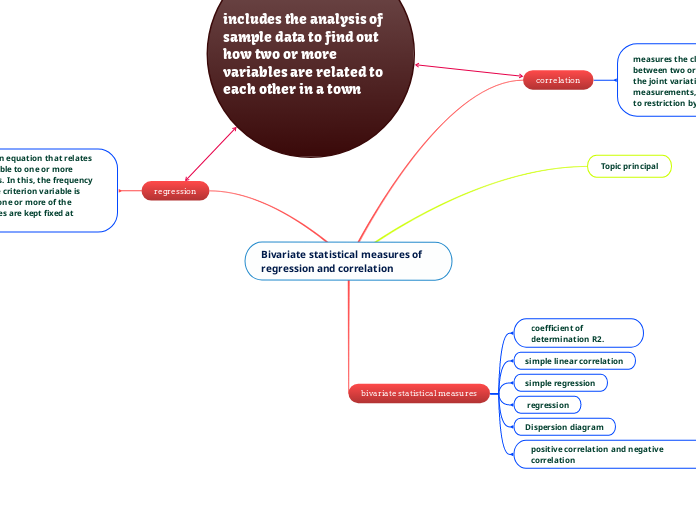Chapters 12, 13, 14, & 15
Davis, 2005
(14) Analysis of Variance and Regression Techniques
the formulas outlined in this chapter are going to important when analyzing data
Nonparametric ANOVA
Kruskal-Wallis ANOVA
Wilcoxon rank-sum test
analyze of the difference between:
an ind var of a categorical nature
a dep var that doesn't contain interval properities
Linear Models
Covariance
long and complicated
ANCOVA
2. fully understand the differences
1. remove extraneous variance - increase precision
Linear regression
multiple linear regression
used to estimate and to look at the intercorrelation
essentially the same as simple linear regression
>1 independant variable
Simple linear regression
analyze the change of the dep var by using info on 1 or more ind var
used to estimate to predict
Two-way analysis of variance (ANOVA)
more complex than the one-way analysis
interaction effect
2 classification variables and 1 dependant variable
One-way analysis (ANOVA)
dependant variable is maintained
ANOVA = analysis of variance
mathematical formulas distinguish: variance/ relationship
mixed effects model
fixed effects model vs. random effects model
The Nature of Variance Decomposition
finding relationships is crucial
the researcher tries to control the error variance
breaking down the variance into explained and error will help the study
variance - the spread of the results
(15) Advanced Multivariate Analysis
it should follow the 3 rules in order for the study to be successful
choosing a technique to fit our study will be important
Comment on the Techniques
rules for choosing a technique:
3. determine the final use of the outcome info.
2. know the data characteristics and requirements
1. acknowledge the assumptions
Analysis of Interdependency
Multidimensional scaling
involves the spatial rep of relations among the perceptions and preferences of individuals
Cluster analysis
attempts to subdivid or partition a set of different objects, variables, or both into similar groups
dimension-free classification procedure
Factor analysis
only performed for very large samples
follows a series of steps
generate a correlation matrix
4. theoretical considerations
3. the indeterminacy problem
2. the # of factors to keep
1. estimates of communality
uses a linear approach
Analysis of Dependency
Covariance structure analysis
researcher specifies the relationships between theoretical constructs and observables
causal modeling
Conjoint analysis
similar to variance
concerned with the joint effect of a combin or rank-ordered ind var on a dep var
stat technique
Multiple discriminant analysis
examines the relationship between:
& a set of exploratory or ind var
a nominally scaled dep var
stat technique
Multivariate anlaysis of variance
a more multivariate nrmal dist is used
uses general linear model & follows similar assumptions of ANOVA
2. takes into consideration that the dep var are correlation somehow
1. provides more total info
examines the effect of a treatment on 2 or more dep var
MANOVA
Selection of a Multivariate Technique
depends on the study and design
Introduction
allow the researcher to examine interactions, dependencies, and commonalities
2. fitting algebraic models to situations
1. means of analyzing phenomena
complex design structures emerged with the innovation of technology
(13) Basic Analytical Methods
these statistical analysis of the data will be important in order for us to interpret the results
Basic Methods of Assessing Differences
t-test for differences in means
mean differences used on interval-scale measures
Z-test for differences in proportions
divided by the standard error of the mean
illustrated by the normal dist curve
Chi-square (x^2) test
test of hypothesis for group differences
Basic Methods of Assessing Association
Pearson's r
summary stat of the strength of the relationship
Spearman rank correlation
the measurement must be ranked for each variable
Kendall tau
Contingency correlation
stronger as it approaches 1
C range 0 to 1
phi coefficient
range -1 to 1
calcs the strength of the relationship
Crosstabulation
shows whether there is a relationship
need the ability to calc percentages
uses categorical data
cross-break
Exploratory Data Analysis
visual displays
scatterplots
box plots
histograms
bar charts
frequency tables
graphical displays
Classification by Purpose
findings could be analyzed with inferential stats and a statistical test of hypothesis
can a discovery be made?
SBR can generalize results where NSBR can not
(12) Planning for Data Analysis
Feel Good Store (project)
SBR would be appropriate because we would want a generalization for the population
choosing analytical software or online research will come down to which is the cheapest and easiest to use
planning is extremely important
with improper planning we could be
developing the wrong conclusion
wasting time and resources
Basic Analytical Framework for Business Research
Scientific business research (SBR)
hypothesis testing
causal
Nonscientific business research (NSBR)
discovery
description/ prediction
exploratory
The Preanalytical Process
Step 7: Tabulation
can be used for crosstabulation and statistical purposes
the results are seperated by how they responded
Step 6: Preanalytical computer check
data is prep'd for computer analysis
Step 5: Data structure generation
data structure is finalized for storage
Step 4: Error check
the coded data is verified before it's transfered to storage
Step 3: Data coding
transfering data into numeric codes
Step 2: Variable development
specifying the variables from the data
Step 1: Data editing
clarity, readability, consistency, and completeness to a set of data
Analytical Software vs Online Research Supplier
Online Research Suppliers
outsourcing the research function
benefits > costs?
expected to grow because of new technologies
Analytical Software
Excel
Microsoft
most popular for it's statistical and analytical tools
SAS
widely used for data anlysis and report writing
SPSS
offers a full line of data analysis products
most widely used
improvements are expected
"point and shoot"
voice recognition
custom software for a specific purpose
availability and familiarity
Planning Issues
In the planning process, the researcher should also prepare for any potential problems
planning is important because it will help the validity of the research









